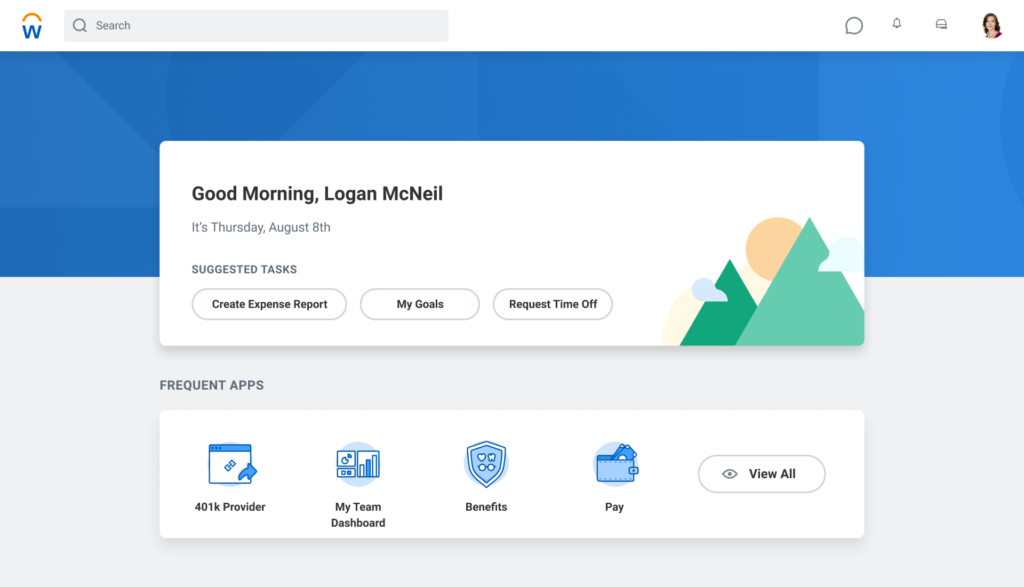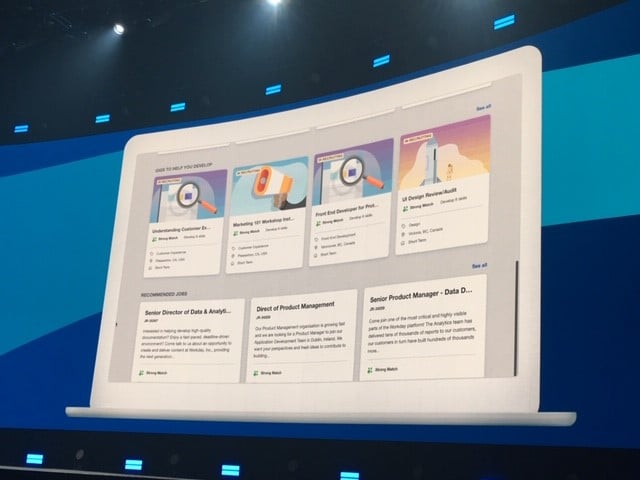The Other Competitor Steps in the Ring: Reflections on Workday Rising 2019
November 18th, 2019
Event Overview
As I wrote about in our article, "The Fight Over Employee Experience Is Finally Here," we expected the Workday team to come out swinging at their annual Workday Rising event. And, wow, did they ever.
Not only did Workday put a heavy focus on employee experience, which they're calling “People Experience” (more on that below), but they also made a wide range of other announcements, including the limited availability of Workday People Analytics, Skills Cloud, and Talent Marketplace.
Before we dive into the details below, here is my main takeaway:
Workday announced products that required them to stretch (People Analytics and Skills Cloud, in particular) at Rising 2018 and we were able to see the fruition of their efforts at Rising 2019, including some early customer stories.
Product announcements & enhancements
While we would like to see more customer testimonials – especially from end-users themselves, not just those responsible for purchasing decisions – we applaud Workday for its diligence in working toward the innovative products they promised last year.
People experience
With that said, let’s move on to some of the key announcements, starting with Workday People Experience (see Figure 1), which is a new user experience (UX). In its description, it's very similar to the new UX that SAP SuccessFactors announced recently – in that it integrates into one location conversational AI, robotic process automation (RPA), machine learning, nudges, and predictions to try to get people higher-quality information more efficiently. Workday People Experience provides information ranging from career development guidance to personalized answers to HR and payroll questions, from both within Workday and external systems.

Figure 1: Workday’s People Experience UX | Source: Workday, 2019.
The biggest differentiator I could discern between the People Experience UX and the one announced by SAP SuccessFactors in September is that Workday seems to have more significantly embraced a critical employee experience concept: journey maps.
The value in using journey maps is that they can identify critical "moments that matter" for specific types of employees and create a standard (and scalable) way of managing (and then improving) those experiences. The result is a much more employee-centric approach to designing software.
Workday identified a number of specific journeys for different employee profiles and used them to create personalized recommendations within Workday People Experience. For example, if a parent is returning to work after welcoming a new child into their family, there are likely a specific set of steps they should go through, such as informing the insurance company, filing leave claims appropriately, etc. Similarly, if someone is recently promoted, there are specific and standardized onboarding and training tasks that need to be completed, which People Experience can recommend. This information automatically populates for those employees within Workday, making it easier for employees to find critical information.
The other addition in the area of employee experience was the announcement of a partnership between Workday and Medallia to allow for the integration of customer experience data with employee data within Workday.
There is clearly value in the integration of these two data sets (see our research on the connection between employee experience and customer experience) and think that this partnership further enables organizations to manage their customer and employee experiences in closer concert and more effectively. It also gives Workday an answer to SAP’s acquisition of Qualtrics, with Qualtrics being another major player in the customer experience space.
People analytics
Let’s move on to Workday’s People Analytics (see Figure 2), initially announced at last year’s Rising event. This solution, which integrates the 2018 Stories.bi acquisition, leverages that technology’s ability to identify patterns within data, process those insights using machine learning, and then highlight the most critical “stories” in natural language. The range of topics covered includes hiring, organization composition, diversity and inclusion, talent and performance, and retention and attrition. Workday People Analytics has limited availability with the Workday 33 release; at Rising, Workday announced a number of customers using it.

Figure 2: Workday People Analytics Solution | Source: Workday, 2019.
As we have discussed in our People Analytics Technology research,
One of the areas many solutions struggle with is in telling clear and compelling stories with the data, and this is something the People Analytics solution is clearly targeting.
This should really help the HR business partners and other leaders who are less quantitatively-focused to grasp new trends quickly. That said, I didn’t get much sense from the RIsing demo of how the more quantitative folks will be able to manipulate the data. I presume the assumption is that customers will use Workday Prism to do that more sophisticated analysis – but I didn’t see an in-depth demo of how to do that at Rising, so we will have to leave that one for another post. Overall, though, this announcement represents progress for Workday on the beguiling people analytics front.
People skills
Let’s move on to Skills Cloud, which is another solution Workday announced last year and brought into production this year.
The idea is that Skills Cloud will “mine” employees’ skills by looking at employees’ job descriptions, any internal online profiles, feedback on their performance, and any other work experiences, and then infuse these skills across the entire platform, including talent planning, talent marketplace, career hub, learning, recruiting, performance enablement, compensation, and people analytics.
This information can then be used to better understand the skills within the workforce and to make more strategic decisions (see screenshot in Figure 3) via the Skills Insight analysis tool. Workday says they have more than 200 customers live on the Skills Cloud.

Figure 3: Workday Skills Insights | Source: Workday, 2019.
As many of you know, we care deeply about skills and are planning to write several pieces of research on this topic in 2020. We love that Workday is making skills such a core part of their overall platform and see huge potential for what they are doing. That said, we have a few concerns:
- Data quality. Many of the data sources Workday is using can be inadequate reflections of someone’s overall skills. We know that employees can change / augment their skills, but we worry that they will not, and that the skills data will not be as robust as it needs to be to make critical strategic decisions.
- Data bias. We know from numerous studies that women and under-represented minorities tend to under-report their skills, while majority populations often over-report their skills. We worry that these types of algorithms will perpetuate biases about people’s skills (or lack thereof).
Neither of these items are show-stoppers, as Workday clearly has to start somewhere when it comes to documenting skills. However, for folks using the technology in its earliest stages, we think these 2 items are something of which to be mindful.
People management
Finally, let’s turn to the Talent Marketplace (see picture in Figure 4), which is a single location that includes internal opportunities that are matched to employees’ skills and interests. Importantly, the solution alerts employees to those opportunities, versus employees having to look for them. The idea is that employees can more easily find internal opportunities that will help them grow, and hence stay at an organization longer.

Figure 4: Workday’s Talent Marketplace | Source: Workday, 2019.
We tend to see internal marketplaces positioned as part of an organization’s learning and development strategy, where the “gigs” give employees a chance to augment their existing work with opportunities that align to their career aspirations. Interestingly, at Rising, Workday positioned Talent Marketplace as a way for organizations to compete against external organizations who could also be sharing new opportunities with an organization’s employees. So, it is not just an internal gig-work marketplace, but also an internal job board that automatically alerts employees to opportunities.
Wrap up
In the course of my conversations with other analysts, we had two questions with internal marketplaces we think have currently gone unanswered:
- What if an employee wants to develop skills they either do not have or are currently weak on? Does the solution allow for them to indicate this, or will the algorithm only suggest things aligned with their current capabilities? And further, will this solution allow them to connect with managers who are willing to coach them, especially since they won’t be a fully committed resource?
- Is there a way to pay people for doing this extra work? Presumably, if it is possible this work would have been given to a contractor, to whom an organization would pay to do it. If the work is going to an internal employee, is there a way to compensate them for it?
Ok, that was more than 2 questions. 🙂 We think there’s great opportunities for internal marketplaces but think there are still some details to get sorted out.
All of these announcements together create a compelling case for why Workday is the competitor to beat when it comes to creating a unified and personalized employee experience.
Many of these solutions are in limited availability, so the market has yet to tell us of the impact — hopefully we will hear that at Rising 2021. Workday is clearly pushing forward with a lot of innovations and we look forward to hearing from end-user customers on how these changes are helping them meet their people and business needs more effectively.